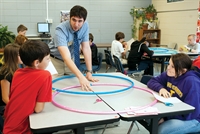As a 20-year veteran middle school teacher, I learned very early in my career that if you don’t physically move middle school students sometime during your lesson or class time, they will move you in ways you wish you could forget. Providing students an opportunity to move is critical to your survival, as well as to helping your students stay engaged throughout your lesson.
Brain research tells us that students can actively listen to their teachers for as many minutes as their age. That means, for a middle school student, 15 minutes is about the longest time they will sit still and listen before they need to get up and move.
Many teachers dread transitions, fear student movement, and think that the less students move the fewer problems they will have in their classrooms. In reality, that mindset is counter-intuitive and works against the very nature of the young adolescent.
The Ground Rules
Before we get them moving, let’s set the ground rules for movin’ and groovin’ in your class.
- Be purposeful in how you move your students. Plan carefully: When will it happen, how will it happen, how long will it take, and how will you refocus them?
- Anticipate the challenges. Is there enough room for the activity you have planned? Can you see all the students while they are moving? Do certain students need to be watched closely?
- Plan how to direct your students back to you and to the lesson. Will you play music, ring a bell, blow a whistle? Did you teach your students what to do when they hear the sound (stop what they are doing, close their mouths, and place eyes on you)?
- Have a back-up plan if the activity fails to meet your expectations. Will you adopt the mantra of “If the movement creates problems, I will never let them move again”? Or will you recognize that students may need to be retaught what is expected of them when they are allowed to move?
Taking the time to consider these ground rules will help you maintain your sanity and help your students stay focused and engaged in the lesson.

Getting students up and moving is easy when you make a game out of learning.
So, let’s get them movin’! Listed below are several ways you can incorporate movement into your classroom. Some examples get students out of their seats for a quick structured break and others are intended to provide movement while students are engaged in the content.
Board Games
Board games are a great way to engage and motivate your students as they review content. To incorporate movement during the board game, add spaces that require students to do 10 pushups or 10 jumping jacks. Not only are students learning, they also are exercising while they are in social studies or math class. Your PE teachers will love you!!
Put the directions on the back of the laminated board game you have created and simply hand out the game. Instruct students to read the directions and get started. Remember Robyn Jackson’s advice from her book, Never Work Harder Than Your Students: Never work harder than your students!
Flip It
The following activity involves the use of an iPad, cell phone, or flip camera. Begin the lesson by giving a brief lecture (no more than 15 minutes) on the topic of the day. Students take notes, then work with a partner to write a 20-word summary of what they learned from the teacher’s brief lecture.
After students complete the 20-word summaries, they must video record each other sharing what they learned, without using notes. Students can videotape using their iPad, cell phone, or flip camera. Limit the length of the video so students are forced to be concise.
Come and Give It—Come and Get It!
A simple way to add movement is to have students carry their assignment to you rather than “passing it forward.” You might suggest that they give you a compliment as they hand it to you. (Brace yourself for complete honesty!) Or give them a compliment!
If I have a paraprofessional in my room, I always have students hand in work to the para along with a compliment. This is a great way for students to build a relationship with another adult in the room.
Another quick and easy method of moving students is to put handouts in different spots around the room and instruct students to go get a handout for themselves.
Brain Breakers
Brain breakers are a great way to diversify any lesson and build community within your class. By changing the pace, you will be adding fun to your class lesson. For example, have your students thumb wrestle.
You can find other brain breaker ideas at www.watchknowlearn.org/Category.aspx?CategoryID=17404. In addition, you might find David Sladkey’s book Energizing the Brain Breaks useful when developing ways to incorporate movement in your classroom.
What’s Your Response?
Try these prompts to get students engaged and moving during question-and-answer time:
- If you agree with this statement, point to the ceiling.
- If you disagree with this statement, pound on your desk.
- If you agree with this statement, stand up and switch seats with someone.
Providing alternative ways for students to respond, rather than by paper and pencil, can give them an opportunity to move and stay engaged.
Let’s Talk
One of my concerns for students in today’s classrooms is the amount of screen time they engage in each day. Developing technology skills is certainly critical to our students’ success, but their ability to speak and present to their colleagues in the workplace must not be sacrificed for technology.
One way to bridge this gap is to divide your class into two groups. Students stand face to face with another student, introduce themselves, shake hands, and take turns answering questions posed by the teacher. Don’t hesitate to toss in some thought-provoking questions as well as questions related to your content; for example, “If you had a chance to fly a plane, fly a helicopter, or man a submarine, which would do you and why?” After both students have answered the question, they rotate to a new partner and begin the process again.
According to Paul Tough, author of Why Children Succeed, these “soft” skills are just as important to success as a person’s IQ.
Movie Time
Engaging this generation using movies as a teaching tool can be challenging. Not every movie is action-packed with objects flying, suspense building, and robots invading earth.
I treat movie watching the way I treat my lesson. About every 20 minutes, I stop the video and do a brain break or have students walk seven steps from their desks. Eric Jensen, researcher in brain-based activities, says having students walk seven steps from their desks and back is enough to get the brain ready for new and more learning.
Pacing
Pacing is a critical component in engagement as well as classroom management. Effective pacing means that you, the classroom teacher, are teaching content and moving students at an appropriate pace throughout the lesson.
David Walsh, author of Why Do They Act That Way?, says, “Kids today want material presented to them in four ways: fast, fun, easy, and more.” I interpret this as a call to create a fast-paced lesson in which students are involved in a variety of activities. Activities may include a brief lecture, partner share, independent work, and a short video clip.
A great teacher recognizes the importance of pacing and is deliberate in planning each lesson with movement and pacing in mind.
Get Movin’!
Mark McLeod, a fellow consultant, says it best: “When the butt goes numb, the brain goes dumb.” That’s true for just about all of us, but especially for our young adolescents. So, get ’em movin’, and I have a feeling you will see better-behaved students, an increase in engagement, and most important, students eager to come to your class.
Kim Campbell is a middle school teacher in the Hopkins School District in Minnetonka, Minnesota. kim.mtm@gmail.com
This article was published in AMLE Magazine, March 2014.
